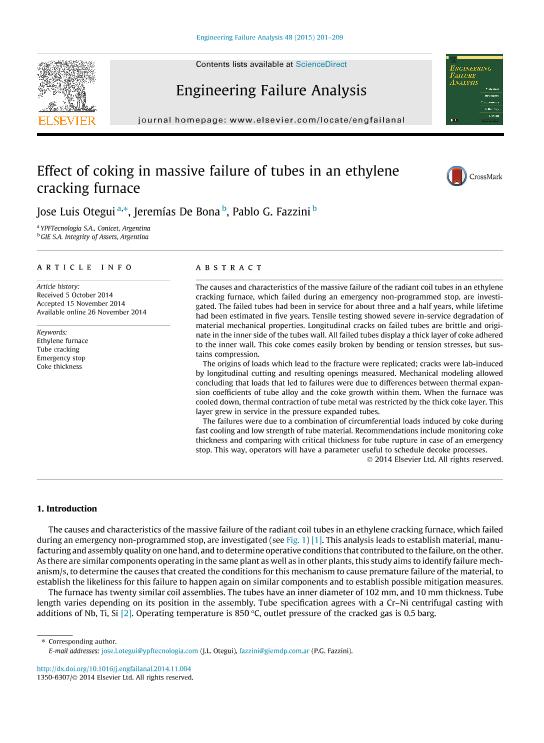Mostrar el registro sencillo del ítem
dc.contributor.author
Otegui, Luis Jose

dc.contributor.author
de Bona, Jeremias

dc.contributor.author
Fazzini, Pablo Gabriel

dc.date.available
2018-02-26T21:37:21Z
dc.date.issued
2015-02
dc.identifier.citation
Otegui, Luis Jose; de Bona, Jeremias; Fazzini, Pablo Gabriel; Effect of coking in massive failure of tubes in an ethylene cracking furnace; Pergamon-Elsevier Science Ltd.; Engineering Failure Analysis; 48; 2-2015; 201-209
dc.identifier.issn
1350-6307
dc.identifier.uri
http://hdl.handle.net/11336/37203
dc.description.abstract
The causes and characteristics of the massive failure of the radiant coil tubes in an ethylene cracking furnace, which failed during an emergency non-programmed stop, are investigated. The failed tubes had been in service for about three and a half years, while lifetime had been estimated in five years. Tensile testing showed severe in-service degradation of material mechanical properties. Longitudinal cracks on failed tubes are brittle and originate in the inner side of the tubes wall. All failed tubes display a thick layer of coke adhered to the inner wall. This coke comes easily broken by bending or tension stresses, but sustains compression. Theorigins of loads which lead to the fracture were replicated; cracks were lab-induced by longitudinal cutting and resulting openings measured. Mechanical modeling allowed concluding that loads that led to failures were due to differences between thermal expansion coefficients of tube alloy and the coke growth within them. When the furnace was cooled down, thermal contraction of tube metal was restricted by the thick coke layer. This layer grew in service in the pressure expanded tubes. Thefailures were due to a combination of circumferential loads induced by coke during fast cooling and low strength of tube material. Recommendations include monitoring coke thickness and comparing with critical thickness for tube rupture in case of an emergency stop. This way, operators will have a parameter useful to schedule decoke processes.
dc.format
application/pdf
dc.language.iso
eng
dc.publisher
Pergamon-Elsevier Science Ltd.

dc.rights
info:eu-repo/semantics/openAccess
dc.rights.uri
https://creativecommons.org/licenses/by-nc-nd/2.5/ar/
dc.subject
Coke Thickness
dc.subject
Emergency Stop
dc.subject
Ethylene Furnace
dc.subject
Tube Cracking
dc.subject.classification
Recubrimientos y Películas

dc.subject.classification
Ingeniería de los Materiales

dc.subject.classification
INGENIERÍAS Y TECNOLOGÍAS

dc.title
Effect of coking in massive failure of tubes in an ethylene cracking furnace
dc.type
info:eu-repo/semantics/article
dc.type
info:ar-repo/semantics/artículo
dc.type
info:eu-repo/semantics/publishedVersion
dc.date.updated
2018-02-26T15:08:03Z
dc.journal.volume
48
dc.journal.pagination
201-209
dc.journal.pais
Estados Unidos

dc.description.fil
Fil: Otegui, Luis Jose. YPF - Tecnología; Argentina. Consejo Nacional de Investigaciones Científicas y Técnicas; Argentina
dc.description.fil
Fil: de Bona, Jeremias. GIE Integrity of Assets; Argentina
dc.description.fil
Fil: Fazzini, Pablo Gabriel. GIE Integrity of Assets; Argentina
dc.journal.title
Engineering Failure Analysis

dc.relation.alternativeid
info:eu-repo/semantics/altIdentifier/doi/http://dx.doi.org/10.1016/j.engfailanal.2014.11.004
dc.relation.alternativeid
info:eu-repo/semantics/altIdentifier/url/https://www.sciencedirect.com/science/article/pii/S1350630714003380
Archivos asociados
